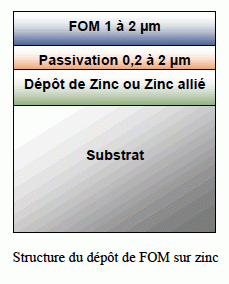Organo-mineral finishes of electrolytic zinc deposits
N.B.: The information contained in this sheet comes from reliable sources. Nevertheless, it is provided without any guarantee, express or implied, of its accuracy.
Principle:
Organo-Mineral Finishes (OMF) are the necessary complement to electrolytic zinc conversion finishes to meet evolving automotive specifications for improved corrosion resistance, even under thermal stress in the engine compartment, control of the coefficient of friction and improved wear resistance.
1. History of organo-mineral finishes
The development of Organo-Mineral Finishes (OMF) or reinforced finishes began in the 1980s when the French automotive industry was looking for ways to resist corrosion when temperatures reached 120°C in the engine compartment. Mechanical parts subject to friction also needed to retain their protection after repeated mechanical stress (e.g. clamping, bending, crimping, stamping).
The researchers found that the incorporation of silica into the chromatations preserved their degree of hydration even at 120°C. The addition of organic waxes in suspension allowed the conversion deposits to slip and exacerbated the self-healing role of the chromic conversions after mechanical injury to the deposits.
The first reinforced finishes appeared in the standards of PSA (specifications B 15 4101, B 15 4102) and Renault (specifications 01-71-002) in the 90s. They concerned in particular the bolts and nuts for which these lubricating properties are particularly sought after to control the friction coefficient. The evolution of automotive standards coincides with the search for quality. In particular, corrosion resistance requirements have increased in terms of resistance to salt spray NF A05 109 or NF EN ISO 9227 from 200h before red rust in 1985 to 400h in 1992, then 600h in 2000 to reach 720h in 2002. This evolution is comparable to what happened in Western Europe during the same period when practically all car manufacturers chose the same policy of quality research.
The protection of the environment is not left out since the European Directives on end-of-life vehicles (ELV or Directive 2000/53) and on the use of hazardous substances (RoHS or Directive 2002/95) have banned the use of hexavalent chromium in chromium conversion passivations. Organo-Mineral Finishes then largely contributed to the promotion of trivalent chromium passivations (e.g. Patent EP1409157 on black deposits on alloyed zinc).
2. Processes
The processes vary according to their appearance, their lubricating function and their application in bulk or on assembly. But the structure of the deposit always remains the same:
FOM with black appearance
These organo-mineral finishes contain organic pigments (dyes) or mineral pigments such as carbon black.
Applications
FOM is usually applied by dipping, integrated in a galvanizing line. However, the complexity of the parts may require spray applications when the dripping effect is prohibitive.
In the dipping process, the parts undergo wet treatments
At the fastener, the parts suspended on a fixture undergo all the galvanizing treatments from preparation to drying before unloading. The FOMs are then of a film-forming nature with resins or varnishes for better adhesion and drip-free drying.
In bulk, the zinc-plated parts in barrels for electrolysis are transferred into centrifuge baskets, usually made of steel. These baskets are used for passivation and immersion in the hardened finish. Variable speed centrifuges can be tilted for better part rotation and uniform processing. FOMs are adapted with less film-forming product and a viscosity adjusted to the centrifuging conditions.
FOM for the coefficient of friction
The demands vary according to the decision makers, the screwing conditions and the needs. There are 4 main classes of friction coefficient:
0,06 à 0,09
0,08 à 0,14
0,09 à 0,15
0,12 à 0,18
French manufacturers generally require categories 1 and 4, whereas Germans require categories 1, 2 and 3. The same variants are found in America but the Japanese use different technologies with coefficients higher than 0.23.
Implementation
Main equipment (furnace, reactor, line, machine...)
If you are a company interested in being listed on this page, please contact us: a3ts@a3ts.org

